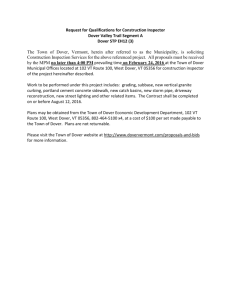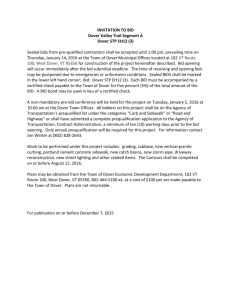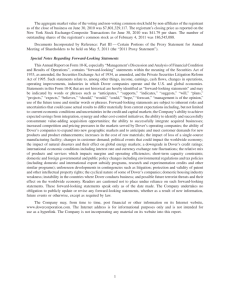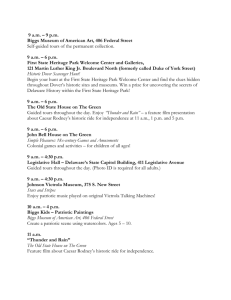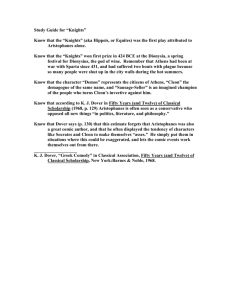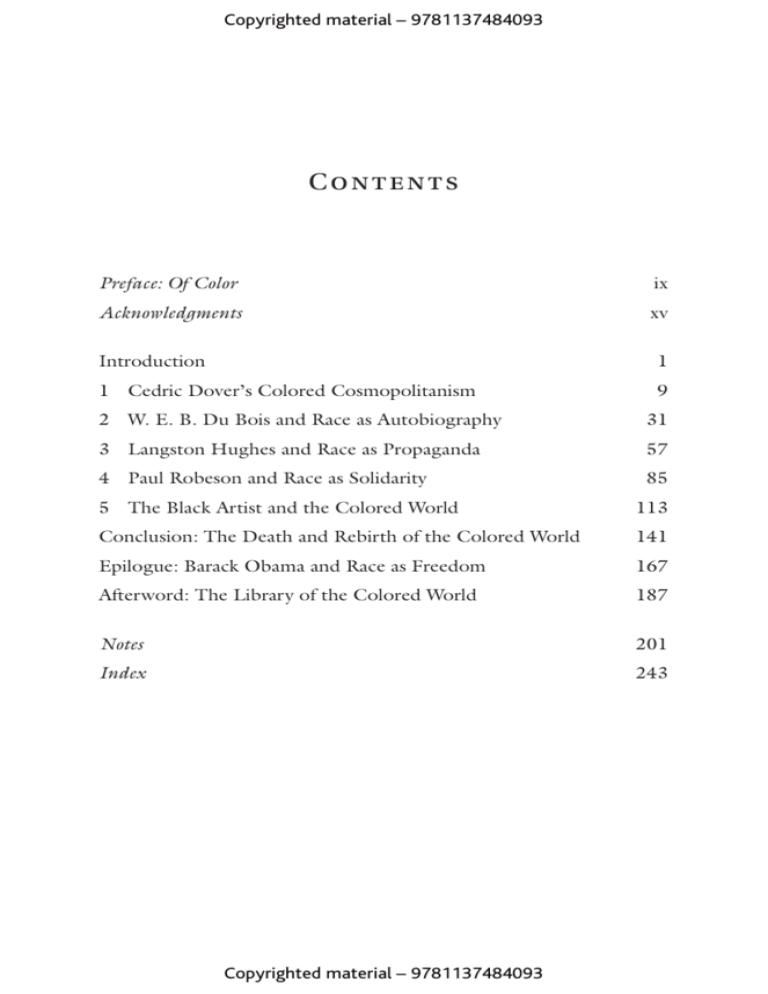
Copyrighted material – 9781137484093
Contents
Preface: Of Color
ix
Acknowledgments
xv
Introduction
1
1 Cedric Dover’s Colored Cosmopolitanism
9
2 W. E. B. Du Bois and Race as Autobiography
31
3 Langston Hughes and Race as Propaganda
57
4 Paul Robeson and Race as Solidarity
85
5 The Black Artist and the Colored World
113
Conclusion: The Death and Rebirth of the Colored World
141
Epilogue: Barack Obama and Race as Freedom
167
Afterword: The Library of the Colored World
187
Notes
201
Index
243
Copyrighted material – 9781137484093
Copyrighted material – 9781137484093
THE PRISM OF RACE
Copyright © Nico Slate, 2014.
All rights reserved.
First published in 2014 by
PALGRAVE MACMILLAN®
in the United States—a division of St. Martin’s Press LLC,
175 Fifth Avenue, New York, NY 10010.
Where this book is distributed in the UK, Europe and the rest of the world,
this is by Palgrave Macmillan, a division of Macmillan Publishers Limited,
registered in England, company number 785998, of Houndmills,
Basingstoke, Hampshire RG21 6XS.
Palgrave Macmillan is the global academic imprint of the above companies
and has companies and representatives throughout the world.
Palgrave® and Macmillan® are registered trademarks in the United States,
the United Kingdom, Europe and other countries.
ISBN: 978–1–137–48409–3
Library of Congress Cataloging-in-Publication Data is available from the
Library of Congress.
A catalogue record of the book is available from the British Library.
Design by Newgen Knowledge Works (P) Ltd., Chennai, India.
First edition: December 2014
10 9 8 7 6 5 4 3 2 1
Copyrighted material – 9781137484093
Copyrighted material – 9781137484093
I n t r o du c t i o n
We must be both “racial” and anti-racial at the same time, which really
means that nationalism and internationalism must be combined in the
same philosophy.
—Cedric Dover, “Notes on Coloured Writing”1
C
edric Dover met Mr. Baker on a farm outside of Tuskegee, Alabama,
in 1937. Dover remembered Baker as “a very grand old gentleman”
who had survived slavery to become “a symbol of the wise, courageous and creative ancestry of the Negro people of America.” Dover
was introduced to Baker by two renowned African American artists:
the painter Aaron Douglas and the conductor William Levi Dawson.
But it was Baker, a farmer and former slave, who Dover made central to his memories of that day. Upon learning that Dover was from
India, Baker told him, “Now I can see us niggers is getting together at
last.” By appropriating the word “nigger,” an epithet used worldwide
to disparage people on the basis of skin color, Baker celebrated the
solidarity of the global struggle against racism. Dover dedicated his
life to building that solidarity. In Baker, he found more than an icon of
Black wisdom. He found proof that oppressed people of color could
unite across the borders of race and nation.2
Born a Eurasian “half-caste” in Calcutta in 1904, Dover encountered in his own life the central paradox of race in the contemporary
world. He knew that race did not exist in blood or bone. He also
knew that across much of the globe, from Calcutta to Tuskegee, the
color of a child’s skin influenced everything: where she could go to
school, what kind of job she could work, whom she could marry, and
how long she would live. Dover realized that not everything racial was
harmful. Many oppressed people found hope in racial communities.
Dover understood that racial solidarity was a powerful tool in the fight
against racism. He learned from an early age, however, that even when
race did not breed hate, it could still close minds and limit compassion. Dover strove to be, in his words, “both ‘racial’ and antiracial at
the same time.” He recognized the interconnectedness of race with
other forms of identity and oppression. He knew that hierarchies of
Copyrighted material – 9781137484093
Copyrighted material – 9781137484093
2
Th e Pri s m o f R ac e
class mapped onto hierarchies of race, making both more intractable.
He used race to fight against racism and kept fighting when a global
order built on white supremacy began to give way to more subtle but
equally pernicious forms of injustice.3
Dover played a central role in one of the most creative redefinitions of racial identity in the twentieth century—the invention of
the colored world. He fostered a global community built upon color
as a marker of shared oppression. Central to this community were
several influential African American activist intellectuals with whom
Dover forged a colored cosmopolitanism that linked the struggles
of “colored peoples” fighting for their rights throughout the world.
Colored cosmopolitans blended an inclusive humanism with pride in
the achievements of African Americans and other “people of color.”
They rejected an overly rigid multiculturalism and a toothless “colorblind” universalism. They bridged multiple identities and political
causes. Combining “nationalism and internationalism . . . in the same
philosophy,” as Dover put it, advocates of colored solidarity respected
anticolonial nationalisms and more local forms of belonging and resistance. Their cosmopolitanism did not hover above the troubled world.
Unlike the stereotypical rootless cosmopolitan, Dover understood the
world as interconnected but not flat. He attended political conferences and corresponded with prominent leaders such as Jawaharlal
Nehru, the first prime minister of India. Dover’s cosmopolitanism was
colored by its attention to race, as well as by its engagement with the
inequalities of a world divided by far more than black and white.4
In 1900, W. E. B. Du Bois prophesied, “The problem of the twentieth century is the problem of the color line.” Although steeped in
the struggle against American racism, Du Bois understood race in a
transnational context. He globalized the color line. His vision encompassed not only the “millions of black men in Africa, America and the
Islands of the Sea” but also “the brown and yellow myriads elsewhere.”
Three years later, writing in The Souls of Black Folk, Du Bois again globalized the color line. He examined “the relation of the darker to the
lighter races of men in Asia and Africa, in America and the islands of
the sea.” Du Bois helped build a global community based on color as
a marker of oppression. His writings, studied throughout the world,
created intellectual bridges between the “darker races of men.”5
Among the many readers of The Souls of Black Folk, none was more
inspired by Du Bois than Cedric Dover. Dover crowned Du Bois the
father of the colored world and praised him for seeing the color line
in a global context. Beginning in the 1930s, Dover ingratiated himself
with Du Bois. He gradually won the older man’s respect and support.
Copyrighted material – 9781137484093
Copyrighted material – 9781137484093
I n t r o du c t i o n
3
As a disciple of Du Bois, Dover positioned himself as a leading proponent of colored unity worldwide.6
Du Bois was one of several eminent African American figures who
shaped Dover’s colored world. The poet Langston Hughes, and the
singer, actor, and activist Paul Robeson, also played important roles
in Dover’s life and work. All towering figures in the African American
community and beyond, Du Bois, Hughes, and Robeson, like Dover
himself, bridged scholarly and artistic pursuits with political struggles in the United States and abroad. Their relationships with Dover
provide a unique window on the relationship between Black internationalism and even more capacious conceptions of the global struggle
against racism, imperialism, and other forms of oppression.7
The literature on Du Bois, Hughes, and Robeson is vast. Each
figure has garnered an abundance of scholarly attention. Their contributions to Black internationalism have not, however, been fully recognized. Divorced from the history of colored solidarity, the narrative
arc of transnational Black activism remains flat. Studying Du Bois,
Hughes, and Robeson in light of their relationship to Dover reveals
a new dimension in the history of African American transnationalism.
Like Dover, all three figures at the heart of this book grappled with
how color could connect social movements throughout the world. All
of them saw in the prism of blackness new opportunities for solidarity.
They did not, however, all envision that solidarity in the same way.
Their differences from each other and from Dover are just as telling as their similarities. Indeed, Dover’s differences with Hughes and
Robeson serve as a microcosm of competing conceptions of race on
the global stage.
While Du Bois and Dover championed colored solidarity, Hughes
and Robeson were moved more by class struggles than by colored
cosmopolitanism. They believed in solidarities among those of African
descent and between them and other oppressed people. At times,
both Hughes and Robeson were supportive of colored solidarity.
Hughes, in particular, occupied a middle ground between class-based
and color-based forms of solidarity. He not only recognized the need
for colored unity but also warned against reifying color and forgetting
the significance of other forms of identity and resistance. Ultimately,
however, for both Hughes and Robeson, class proved a more compelling form of connection than color.
It is important to not overstate the significance of colored cosmopolitanism. Globally, several of the most influential advocates of a unified African Diaspora abhorred notions of color. For Marcus Garvey,
the word “colored” evoked hierarchies of skin-tone that divided
Copyrighted material – 9781137484093
Copyrighted material – 9781137484093
4
Th e Pri s m o f R ac e
Black communities. Born in Jamaica in 1887, Garvey came to the
United States in 1916. With Harlem as his base, Garvey launched
the Universal Negro Improvement Association (UNIA), the largest African American organization in its day. Garvey reached out
to Mahatma Gandhi and envisioned a global struggle against white
supremacy. But he framed his vision in terms of the African Diaspora
and rejected solidarities of color. The very word “colored” reminded
him of the mixed-race elites in his native Jamaica. As Garvey makes
evident, the Caribbean produced many of the most influential Black
internationalists, but colored solidarity was weaker there than in the
United States.8
In the Caribbean and elsewhere, colored solidarity was complicated by the efforts of “mulattos” and nonblack people of color to
ascend the status hierarchy by distinguishing themselves from Blacks.
In several of the most ethnically diverse countries in the world, including Brazil, Trinidad, and South Africa, color often divided oppressed
minorities. In South Africa, the word “coloured” came to designate a
heterogeneous ethnic community defined largely by racial mixture. A
blend of the indigenous Khoisan, Bantu-speaking Africans, Europeans,
and Malay migrants and former slaves, the hybrid “Cape Coloureds”
anticipated the transracial nature of Dover’s colored world. Their distinct identity within South Africa complicated, however, efforts to link
the Cape Coloureds to larger visions of global antiwhite solidarities.
Diversity within nations often complicated solidarities across national
borders.9
The relative homogeneity of the African American community
helps to explain why it was among African Americans that Dover’s
colored world flourished most dramatically. African Americans were
not, of course, homogenous. Historians have long known that the
“one-drop rule” expanded the racial borders of the category “colored” or “Negro” in ways that raised the value of “passing” and created hierarchies of color within the African American community. Du
Bois and Garvey, despite their many differences, agreed that color
often divided African Americans. “If India has her castes,” Du Bois
wrote, “American Negroes have in their own internal color lines, the
plain shadow of a caste system.” Garvey declared, “There is more bitterness among us Negroes because of the caste of color than there is
between any other peoples, not excluding the people of India.” Du
Bois and Garvey both used caste in India to decry color discrimination among African Americans. Compared to other countries, however, the United States offered a starkly dichotomous racial system, in
which the line between white and black reigned supreme.10
Copyrighted material – 9781137484093
Copyrighted material – 9781137484093
I n t r o du c t i o n
5
As a minority in a sharply racialized nation, African Americans found
hope in the rise of the colored world. The vibrant African American
press and African American scholarly community strengthened a widespread sense of connection with people of color overseas. In colored
cosmopolitanism, Dover and his colleagues found a transnational path
to achieving unity despite the diversity of the African American community and the larger colored world. That sense of global unity mattered to many African Americans. They looked beyond the differences
that divided the colored world.
Dover also looked beyond those differences. Indeed, his enthusiasm for colored solidarity at times blinded him to the many differences
between people of color worldwide. Like many of his contemporaries,
Dover reified “race men” and overlooked the vital role that women
played in struggles against racism worldwide. In his novel, Dark
Princess, Du Bois placed a courageous woman at the heart of a global
struggle to unite the world’s colored peoples. We need not appeal to
fiction, however, to recognize the vital significance of women to the
colored world. The fact that this book revolves around men is not an
indication of the importance of women in defining and defending
Black internationalism. Indeed, Shirley Graham Du Bois and Eslanda
Goode Robeson contributed as much as their more famous husbands
to building a global struggle against racism and imperialism. While
occasionally attacking sexist discrimination, Dover largely failed to
recognize the leadership of women or to denounce gender inequality as an essential component of the injustice he aimed to undo. Like
most of his male colleagues, Dover slipped into a masculinized conception of global solidarity, in which mobility and agency adhered first
and foremost to men.11
Dover was better at recognizing and attacking class inequalities.
Even in regards to class, however, Dover’s zeal for colored solidarity
could blind him to important distinctions. How much did Dover, an
intellectual from Calcutta, really share with a Black farmer in Alabama
like Mr. Baker? Dover grounded the “feeling of unity” between Baker
and himself in “colour as a symbol of difference between oppressors
and oppressed.” “Its binding quality is oppression,” Dover explained,
“its impulse the will somehow or other, some day or other, to lay
down the heavy load.” But did Dover and Baker carry the same load?
Dover offered little insight into Baker’s life. Did Baker own his own
land? How much education had he received? By avoiding the particulars of Baker’s life and eliding the diversity within the African
American community, Dover erased the distance between himself
and Baker.12
Copyrighted material – 9781137484093
Copyrighted material – 9781137484093
6
Th e Pri s m o f R ac e
While he ridiculed an easy solidarity based in biological notions of
race, Dover’s desire to unify antiracist struggles led him to universalize the experience of being dark-skinned in a world of white privilege.
Such universalism carried two distinct risks—the risk of irrelevance
and the risk of essentialism. If colored solidarity was to be relevant,
it needed to speak to and for more than a handful of intellectuals.
Colored cosmopolitanism stood to gain political influence to the
degree that it was embraced by colored people—the vast majority of
whom did not see themselves primarily as colored but as Black or
Indian, Puerto Rican or Gujarati, Hindu or Muslim, high class or
working class. Like all utopian ideas, however, Dover’s vision of unity
among colored peoples did not need to be embraced fully by large
numbers of people to have significance. Partial affiliations mattered.
Many proponents of colored unity were even more strongly committed to another form of identity. Nevertheless, a small group of skilled
publicists like Dover employed the threat of colored solidarity to pressure powerful whites. During the Second World War, colored cosmopolitans used the threat of Japanese propaganda to pressure American
leaders to confront racism at home, lest “colored” countries such as
China and India join the Axis. The Cold War only strengthened such
a political calculus. American politicians, eager to curry favor with
newly independent nations, recognized the diplomatic importance
of civil rights. The relationship between the Cold War and the civil
rights movement hinged on connections between people of color
worldwide.13
In the spring of 1961, Khwaja Ahmad Abbas, a renowned Indian
novelist and screenwriter, published a short story in the left-leaning
Indian periodical Blitz. Titled “Black Sun,” the story followed the
ghost of recently murdered Congolese President Patrice Lumumba
on a visit to the United Nations in New York. Lumumba’s death had
become a rallying cry for critics of American foreign policy. In his
story, Abbas used the death of Lumumba to link American imperialism to American racism. On the streets of Manhattan, Lumumba finds
a series of characters all harmed by white supremacy, including several African Americans and an Indian reporter. The story reveals that
Dover was far from alone in using Afro-Indian solidarity as a Cold War
weapon. Its language and images evoke darkness in ways that symbolize the significance of the colored world to many of Dover’s contemporaries. It is no surprise that, like Dover, Abbas was on the left of
the political spectrum. By focusing on the intersection of American
foreign policy and American racism, Abbas offered a range of new
forms of solidarity.14
Copyrighted material – 9781137484093
Copyrighted material – 9781137484093
I n t r o du c t i o n
7
Like Abbas, Dover wielded colored unity as a weapon in the struggle against racism and class-based inequality. His was a transnational
“strategic essentialism,” a purposeful disregard for the boundaries of
race and nation in service of a unified resistance to racism and imperialism. The risk of essentialism, even a strategic essentialism like that
used by Dover, stemmed from the possibility that the need for unity
might prompt advocates of colored solidarity to ignore the diversity of
the colored world. Dover recognized that inequalities existed within
the colored world. Often structured around differences in race, class,
gender, language, religion, or color itself, these inequalities called
for redress. The ability of colored cosmopolitanism to be liberating
depended on the degree to which it could claim allegiance across the
colored world while recognizing the inequalities that fractured that
world. Colored cosmopolitans advocated multiple overlapping identities. Dover was proud to be Indian, to be an advocate of worker’s
rights, and to be a member of the colored world. Ultimately, however,
Dover failed to respect the full range of diversity within the colored
world. His silence on issues of gender is only the most significant
absence in Dover’s colored world. Indeed, equally troubling is the
way that he attempted to paint over the different conceptions of race
that distinguished him from his closest friends and collaborators.15
Dover attempted to whitewash the differences between his views
of race and color and those of Hughes and Robeson. In his zeal to
craft a coherent Black internationalism, Dover failed to live up to the
greatest insight of his colored cosmopolitanism: the need to respect
difference even while forging solidarity. In his desire for uniformity,
Dover resorted to a crass ventriloquism. He attempted to use Hughes
and Robeson to advance his own ideas about colored unity. The boldness of Dover’s efforts make his a unique case. But the seduction of
simplicity is a danger for all advocates of sweeping solidarities. Dover
was not alone in failing to meet the challenge of achieving a unity that
was respectful of difference.
Grappling with Dover’s failings should not preclude recognizing
his achievements. Dover’s greatest contributions to colored solidarity
were intellectual products: his writings, the several edited volumes he
published in the United States and abroad, his extensive collection
of African American books, and his voluminous correspondence with
other artists and intellectuals. Dover believed that science, art, and literature should contribute to politics—and most importantly, to a sense
of connection between seemingly disparate struggles. Toward that
end, he spent much of his life forging links between African Americans,
Africans, and Asians. Dover encouraged African American authors to
Copyrighted material – 9781137484093
Copyrighted material – 9781137484093
8
Th e Pri s m o f R ac e
publish in London and in India. He fostered intellectual relationships
between Asia and Black America that were simultaneously transnational and transdisciplinary. Dover’s own writings include and often
combine anthropology, literary analysis, poetry, history, and politics.
Originally trained as an entomologist and a forester, Dover published
in the journal Science and in the Proceedings of the Indian Academy of
Science, wrote articles on a sixth-century Black Arab warrior-poet, and
authored a book of poems. Dover’s transdisciplinary ambitions connected him to Du Bois, Hughes, and Robeson—all of whom defined
themselves as artists and activists. Their relationships transgressed
not just national borders but also the boundaries between artistic
endeavor, knowledge production, and political action. In his partnerships with African American scholars, artists, and activists, Dover
demonstrated the interconnection of racially defined scholarly communities, the production of knowledge concerning race and ethnicity,
and antiracist social movements. Well before the rise of Black Studies
and Ethnic Studies departments and the debate on multicultural canons, Dover and his colleagues defended the scholarly integrity of what
Dover called “coloured writing.”16
When Du Bois defined the problem of the twentieth century as
the problem of the color line, he could only have imagined the winding path that line would take in the years ahead. To understand the
history of the color line, we must examine not just relations between
white and nonwhite but also between all those defined as “colored.”
We must return to the origins of colored cosmopolitanism, to a time
in which white supremacy reigned supreme and Du Bois had only
just begun to dream of a united colored world. A year after Du Bois
declared the centrality of color to the history of the twentieth century,
Cedric Dover was born across the color line in Calcutta.
Copyrighted material – 9781137484093
Copyrighted material – 9781137484093
Index
Abbas, Khwaja Ahmad, 6, 69
Abrahams, Peter, 108, 189
Alexander, Tania, 24
Alexander-Sinclair, Maureen,
10, 139
Ali, Muhammad, 145
Ali, Shahid Agha, 155
Almanza, Susana, 151
American Negro Art, 27, 113–40
Anand, Mulk Raj, 15, 51–2, 66, 75
Annandale, Nelson, 12
Antar, ibn Shaddaad, 124
Anzaldúa, Gloria, 146–8
Ashraf, Mahomed, 52
Aryan, ix–x, 16–17, 40
Associated Negro Press, 23, 139
Atlantic Charter, 64
Aublet, Jean Baptiste Christophore
Fusée, 192
Baker, Mr., 115–16, 121
Baldwin, James, 77
Bandung Conference, 50, 108,
115, 143
Baraka, Amiri, 145
Barnett, Claude, 23
Barthe, Richmond, 136–8
Bearden, Romare, 122–3, 125–6,
129, 133
Beck, Glenn, 185
Bethune, Mary McLeod, 70
Bishop, Marjorie, 121
Black Power, 132, 139, 145–6,
156, 160
Blackman, Peter, 108
Blitz Magazine, 6, 23
Bloom, Harold, 33, 82
Blum, Edward J., 35
Bontemps, Arna, 21, 31, 125,
135, 192
Bose, Subhas Chandra, 67
Bourne, Randolph, 159, 197
Brady, Mary Beattie, 128
Brown, Sterling, 23, 77, 187–8
Brown Phoenix, 34, 74–82, 174–5
Browne, Bob, 145
Bumpers, Eleanor, 149–50
Cameron, Barbara, 146
Carmen, Andrea, 151
caste, x, 4, 10, 16–18, 40, 42, 65
Caucasian, ix–x, 40, 184
Chand Anasuya Gyan, 175
Chattopadhyaya, Kamaladevi, 64–5,
69, 105–6
Chavis, Benjamin, 152–3
Churchill, Winston, 10, 15, 64
Cimmerii, 27–8
Cold War, 6, 23–7, 50, 84–8, 91–5,
102–4, 110, 143
Colored Cosmopolitanism, xi–iii,
2–8, 17–19, 21, 26–33, 50,
144–5, 161
communism, 22–4, 26, 51, 79,
87–91, 95–101, 110, 142, 193
Communist Party of India, 22,
93–4, 142
Communist Party of the United
States, 90
Congress Socialists, 22, 24, 26,
49, 198
Cortor, Eldzier, 116–17
Copyrighted material – 9781137484093
Copyrighted material – 9781137484093
244
Index
Crite, Alan, 126
Cullen, Countee, 22, 124
Cunard, Nancy, 61
Dadoo, Yusuf Mohamed, 95
Dark Princess, 39–40
Das, Taraknath xi
Dawson, William Levi, 1
Derozio, Henry Louis Vivian, 78
Dewey, John, 179
Dies, Martin, 101
Dixon, Thomas, 136
Dolla, Abba, ix–x
Dollard, John, 16
Douglas, Aaron, 1, 21, 115, 117,
125–6, 128, 133, 138–9
Douglass, Frederick, 83, 172, 197
Douglas, Norman, 191–2
Dover, Dorothy, 31, 188
Du Bois, William Edward Burghardt
(W. E. B.), xi, 2, 8, 22, 25, 29,
31–56, 66, 75–6, 82, 86–7, 94,
96, 100–3, 132–3, 141–3, 152,
154, 156, 162–4, 172–3, 176,
177, 188–90, 193, 195, 198
DuBois, Shirley, 5, 52, 101, 133
Dunbar, Paul, 81
Duncanson, Robert S., 127, 133
Dunn, Eugenia, 127
Durkhein, Emile, 110–11
East Indian, West Indian,
54, 105, 135
Eastman, Max, 92
Edmonson, William, 125–6
Edwards, Brent Hayes, 34, 173
Environmental Justice, 150–3
Eugenics, 14–15, 38, 45, 198–9
Fax, Elton C., 128–9
Federal Bureau of Investigation
(F.B.I.), 101
feminism, 5, 39–40, 146–50,
181, 194
Fitzgerald, F. Scott, 197
Fort-Whiteman, Lovett, 90
Franco, Francisco, 62, 88
Franklin, John Hope, 20, 22, 31
Frazier, E. Franklin, 21, 137
Freedom Schools, 59
Fukuyama, Francis, 180
Galton, Francis, 14–15
Gandhi, Indira, 94, 150
Gandhi, Mahatma, xi, 4, 37, 64, 67,
92, 182
Garvey, Marcus, 3, 132, 173
Gilroy, Paul, 29, 173
Glicksberg, Charles I., 44–6,
120, 157
Gupta, Sachipada, 71
Gupta, Vanita, 184
Haley, Alex, 163–4, 174
Haley, Nikki, ix, 183–4
Half-Caste, 14–18, 105
Hall, Jacqueline Dowd, 171, 179
Hamilton, Terrick, 198
Hammerstein, Oscar, 85
Harlem Renaissance, 71, 118, 134,
137
Harris, Abraham, 187
Hart-Celler Immigration &
Nationality Act, 144
Hayes, Roland, 64–5
Heidegger, Martin, 117
Hell in the Sunshine, 198
Herskovits, Melville, 120
Higginbotham, Evelyn Brooks, 192
Hitler, Adolf, 62, 88, 100
Hollinger, David, 145, 157–8,
161–3, 170, 196
Hooks, Earl J., 129
House Committee on Un-American
Activities, 95
Houston, Charles Hamilton, 103
Hughes, Langston, 3, 7, 8, 22–4,
31, 46, 54–84, 86, 96, 118, 132,
135–6, 139, 141, 156, 172, 174,
195, 198
Hurston, Zora Neale, 189
Huxley, Julian, 15
Copyrighted material – 9781137484093
Copyrighted material – 9781137484093
Index
245
Indian National Congress, 11, 23,
49, 67, 89, 93
Indian Progressive Writers
Association, 61–2
Ingram, Peter, 39
Ivy, James, 103, 193
Mivart, George, 191
Montgomery Bus Boycott, 115, 122
Moraga, Cherrie, 146–9, 194
Morgan, Norma, 129–30
Mosley, Oswald, 44, 156
Mussolini, Benito, 62
Jackson, Jesse, 177
Jackson, May, 136
James, C. L. R., 198
James, William, 53, 179
Jealous, Benjamin, ix, xi
Jim Crow, 63–5, 68–9, 96, 103,
139, 176
Johnson, Charles, 22, 31, 122
Johnson, Georgia Douglas, 135
Johnson, James Weldon, 120
Joseph-Mitchell, Malcolm, 108
Natarajan, Swaminathan, xi
National Association for the
Advancement of Colored People
(NAACP), ix, xi, 20, 25, 31, 59,
89, 91, 103, 118, 120, 142, 179
Negritude, 29, 89
Nehamas, Alexander, 33, 170
Nehru, Jawaharlal, 2, 14, 21–2, 24,
31, 57, 63–4, 67, 83–4, 92–4, 99,
142, 150, 183
Neruda, Pablo, 61, 92
Nietzsche, Friedrich, 170, 180
Norton, Eleanor Holmes, 151
Kallen, Horace, 158–9
Khan, Shahrukh, 167, 169
King, Martin Luther, 70, 155–6,
182–3, 185
King, Rodney, 157
Know This Of Race, 91
Koestler, Arthur, 79
Kripalani, Sucheta, 70
Lenin, Vladimir, 25, 91
Locke, Alain, 21–2, 83, 119–20, 122
Logan, Rayford, 16, 189
Lorde, Audre, 147, 149–50
Lumumba, Patrice, 6
Mahadevan, T. K., 73
Mahgoub, Mohammed, 108
Makonen, Ras, 12, 108
Malcolm X, 145, 164–5, 179
Mannin, Ethel, 45, 107
Martin, Trayvon, 169
McKay, Claude, 22, 53–4, 60, 91–2,
109–10, 189
Meherally, Yusef, 43, 63
Mendez, Chico, 153
Menon, V. K. Krishna, 14, 96
Miller, Kelly, 136
Obama, Barack, xiii, 161, 165
Obama, Michele, 178
Ohn, Maung, 108
Orwell, George, 24, 26, 109–10
Ostrovsky, Nikolai, 99–100
Pabaney, Aziz, 69–70
Padmore, George, 14, 90, 108, 195
Pan-Africanism, 29, 35, 50, 82–3,
89, 108, 195
Pandit, Vijayalakshmi, 70, 94
Panikkar, K. M., 23
Pankey, Aubrey, 108
Parks, James, 139
Pauloo, Y. M., 96
Phule, Jotirao, 18
Porter, James A., 119
Prattis, P. L., 93
Prophet, Elizabeth Nancy, 51,
113–14, 128
Qi, Baishi, 119
Rahman, Munib, 52
Rai, Lala Lajpat, 18
Copyrighted material – 9781137484093
Copyrighted material – 9781137484093
246
Index
Rajaratnam, Sinnathamby, 17
Rao, N. S. Subba, 41–2, 44
Reyneau, Betsy Graves, 122
Rhee, Syngman, 151
Robeson, Eslanda, 5, 63, 86, 91–2,
94, 106–7, 195
Robeson, Paul, 3, 7–8, 22, 24–5,
27, 46, 63, 70, 84–112, 141–2,
156, 172, 195, 198
Robinson, Edwin A., 78
Roosevelt, Franklin Delano, 64, 183
Rorty, Richard, 111
Said, Edward, 32
Saklatvala, Shapurji, 92
Sampson, Edith, 94
Sanhari, Ramesh, 23
Sauvy, Alfred, 143
Sawyer, Ann, 135
Schuyler, George, 57, 59
Scottsboro Boys, 90
Selassie, Haile, 62
Shaddad El-Absi, Antar Ibn, 74
Shelby, Tommie, 36, 177
Singh, Iqbal, 52
Singh, Jagjit (J. J.), xi
Singh, Manmohan, 183
Singh, R. Lal, 63–4
Skinner, James, 27
Small, Gail, 151
Spanish Civil War, 24, 62, 88, 92
Spingarn, Arthur, 31
Sollors, Werner, 158
Soviet Union (USSR), 20, 23–5, 27,
50, 63, 67, 84, 86–8, 90–100,
108, 110–11
Stalin, Joseph, 25, 87–8, 100
Summit Avenue Ensemble, 36
Tanner, Henry, 133
Tendulkar, Dimnath Gopal, 92
Thind, Bhagat Singh, 10–11
Third World, 50, 115–16, 142–3
This Bridge Called My Back, 146–9
Timmerman, George Bell, 96–7
Universal Negro Improvement
Association (UNIA), 4
United Asia, 22–3, 28–9, 41, 73–4,
82, 98
Vechten, Carl Van, 121, 192
Verhaeren, Emile, 28
Vivekananda, Swami, 18
Walker, David, 172
Warner, Lloyd, 16
Washington, Booker T., 37–8, 190
Washington, Harold, 177
Wells, James, 137
West, Cornell, 169–70
White, Charles, 127, 131, 136
White, Walter, xi, 25
Whiteness, ix, 58, 152, 184
Wilson, Ed, 139
Wilson, Woodrow, 19
Wood, Mercia Hayes, 11, 31, 194
Woodruff, Hale, 127, 129, 133
Woods, Tiger, 157, 161
Woodson, Carter G., 59
Wootton, Barbara, 109
Wright, Jeremiah Rev., 179
Wright, Richard, 108
Yarbro-Bejerano, Yvonne, 148
Zwerg, Jim, 197
Copyrighted material – 9781137484093

